#inspired by a portrait by john singer sargent
Explore tagged Tumblr posts
Text

It is the green-eyed monster which doth mock The meat it feeds on
#tma#the magnus archives#elias bouchard#tma fanart#my art#i tend to headcanon elias as pretty boring-looking. handsome but unassuming. his desk worker vibes have bewitched me.#the monocle is both for the necessary self-indulgent 19th century touch and obligatory eye motif#inspired by a portrait by john singer sargent
141 notes
·
View notes
Text
The vibe. The pose. The beauty.

Portrait of Helen Vincent, Viscountess D’Abernon, 1904 John Singer Sargent
2K notes
·
View notes
Text

Okay this one is a little silly. Who knew the painting it's a study of without checking? XD
Portrait of Madame X by John Singer Sargent is a scandalous, super famous painting. This was mostly just for fun, running on extreme burnout with more than 10 mermaids to go is a tall order. Aka I tried to cut myself some slack here, pick something quick and uncomplicated.
(In order to finish enough mermaids to fill my self-appointed deadline in time I am not going to be finishing colorized versions of all of them. The amount of time it takes to color and shade just wasn't possible...which means only coloring book owners will get to see some of them until I get inspired to finish them up!)
I am the artist! Do not post without permission & credit! Thank you! Come visit me over on: instagram, tiktok or check out my coloring book available now \ (��• ֊ •„) /
https://linktr.ee/ellen.artistic
#portrait of madame x#historical mermaids#ellen artistic#ellenart#digital illustration#mermaids#the burnout is real guys#I'm applying to retail jobs and despair
297 notes
·
View notes
Text
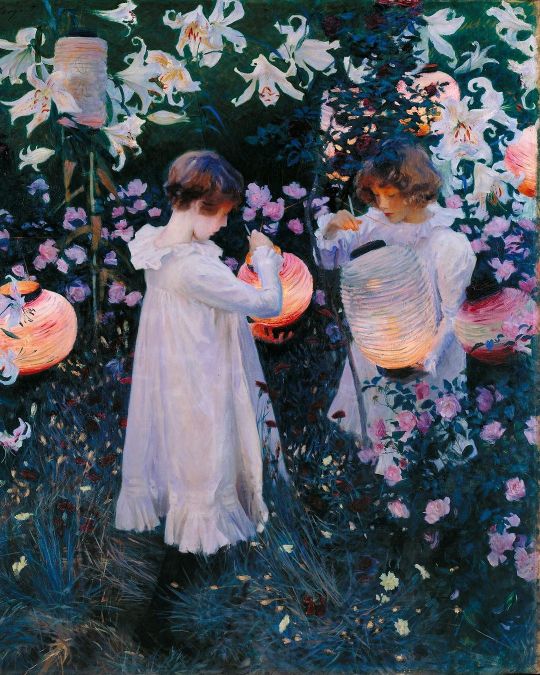

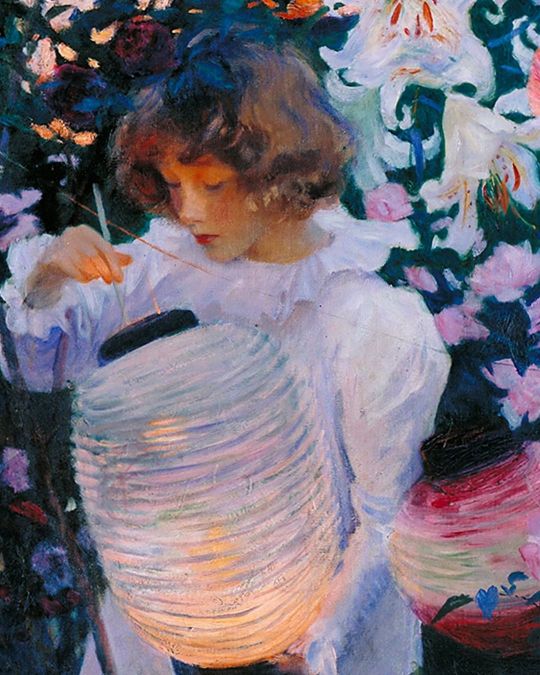
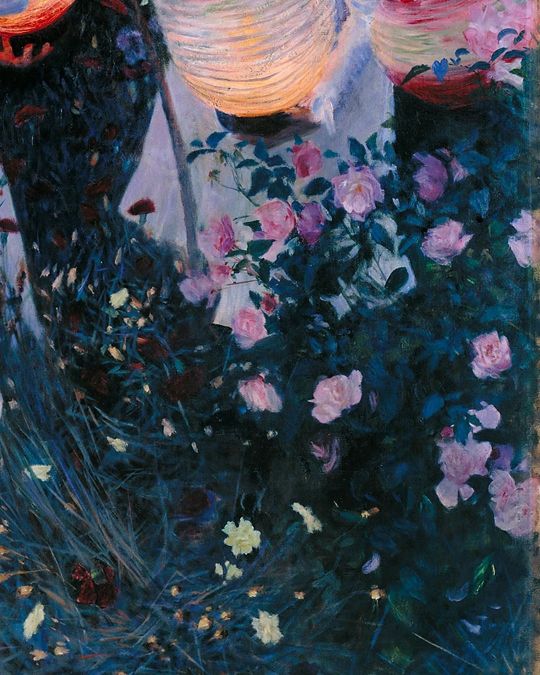
CARNATION, LILY, LILY, ROSE /1885/ by JOHN SINGER SARGENT
The painting shows two young girls lighting lanterns in what seems to be a garden at dusk. The artist used the 'en plein air' technique to capture the beautiful floral hues, which are pink roses, yellow carnations, and white lilies.
The painting's title was inspired by the song "Ye Shepherds Tell Me" by Joseph Mazzinghi. In the song's refrain, Mazzinghi mentions, "A wreath around her head, around her head she wore, Carnation, lily, lily, rose" when you think about it this directly relates to the flowers in the painting.
While in England, Sargent worked on this painting, he moved there because of the scandal from his 1884 painting 'Portrait of Madame X', which damaged his reputation in Paris. The painting, rather controversial, depicts Virginie Gautreau in ways that sparked outrage in Paris due to its provocative elements.
Ultimately, this painting revived Sargent's career after the 1887 Royal Academy exhibition. Some critics praised it for originality, with one radical publication calling it "the most interesting and original picture in the whole show" due to its innovative use of color and light.
199 notes
·
View notes
Text
"Darling, bad luck seems endless." - Bucky Barnes - 2

Summary: You've always been haunted by bad luck your entire life, despising it deeply, until you meet someone who finds it amusing.
Character: softdark!Bucky Barnes x Female!Reader
Chapter 1 , Chapter 2 .
Author's Note: Hello, everyone; this story is for thesleepover eventhosted by @the-slumberparty. What I chose is a strawberry sundae with gummy bears as the topping.
Main Masterlist || support: Ko-fi
Thank you to anyone who gave a like, reblog, and left a comment. It motivated me to write more.

Bucky didn’t trust you yet. To test if what you said about your lousy luck was true, he sent you to his competitor, Damien, a mafia boss who owed money to Bucky.
Damien spent most of his time at a museum. Bucky gave you an order, “And I want to see if what you said is true.”
You didn’t thoroughly dislike the idea because, as an artist, you enjoyed going to museums. The museum was a grand, historical building with high ceilings and intricate architecture. Walking through the halls filled with timeless masterpieces, you felt a sense of calm despite the task at hand.
As you wandered, you spotted Damien. He was exactly as Bucky had described: an older man, about the same age as Sir Galileo, with an air of authority and a sharp gaze. You stood at a respectful distance, admiring the same painting he was fixated on—"Portrait of Madame X."
Noticing your interest, Damien turned to you. “A fine piece, isn’t it?” he said, his voice rich and cultured. “John Singer Sargent’s ‘Portrait of Madame X’. It caused quite a scandal when it was first exhibited.”
You listened intently as he explained the history and significance of the painting. His passion for art was evident, and you found yourself genuinely engaged in the conversation.
Suddenly, your phone rang. It was Bucky. “Where’s the bad luck? I see you talking to him without anything happening,” he demanded.
“Uhm…” You hesitated. You never knew when bad luck would strike.
Just then, a scream pierced the air. “Kyaa!”
You turned to see another visitor pointing in horror. The painting you had been admiring had fallen off the wall, landing dangerously close to Damien. You were too stunned to speak.
“No kidding,” Bucky muttered through the phone, equally shocked. It seemed impossible for a securely hung painting to suddenly fall in a museum. He was beginning to believe your curse might be real.
For the second test, Bucky sent you to a café. “Just choose a table and sit near my other competitor, Ivan. It’s an easy task,” he instructed.
You entered the cozy café, its atmosphere warm and inviting with the smell of freshly brewed coffee and pastries. You found a table near Ivan and started sketching another jewelry design for Bucky.
Ivan, seated nearby, glanced over and noticed your drawing. “That’s quite impressive,” he remarked, leaning in slightly.
“Thank you,” you replied, offering a polite smile.
“What inspires your designs?” he asked, genuinely curious.
Before you could answer, a waitress tripped and spilled a hot cup of coffee right onto Ivan’s thigh. He yelped in pain and surprise, the conversation abruptly ending.
Bucky, watching everything unfold on a screen, was astounded. “You really do bring bad luck.”
“...” You remained silent, unsure of how to respond.
“But I’m getting all the advantages,” Bucky continued with a sly grin. “Thank you.”
You didn’t know whether to feel offended or relieved that Bucky was starting to believe you.
The last incident that convinced Bucky was when he brought you to a ball party hosted by another gangster whom Bucky despised, who was there to show off his wealth.
The host planned to reveal a rare diamond during the party, but it was stolen. This was unexpected and seemingly impossible due to the high level of security. While everyone else panicked, Bucky remained calm. He looked at you and said, "You’re my lucky charm."
🍀🍀🍀🍀🍀
All these experiences made your once dull life exciting. You started to appreciate the bad luck you had. You realized that working with Sir Galileo was the longest job you had ever held.
One day, you asked him if he had ever faced misfortune. Surprisingly, he said, “I did. My former driver got into an accident, and the electricity short-circuited on the first day you worked here.”
You were shocked and felt guilty. “It must be because of me.”
He shook his head and said, “It’s nothing. I’ve lived a long time and faced a lot of things, especially working with gangsters and mafia. I just keep on living.”
‘Just keep on living.’ He’s right. Even with bad luck, you continued living. Life always punched you to the ground, but you got back up again.
Slowly, you started liking your bad luck. You experienced exciting events, even assisting Bucky in getting rid of his rival businesses.
But then you noticed that your bad luck didn’t happen as often. In fact, you started getting lucky.
You found $100 on the street one day, got a free coffee when the barista mistakenly made an extra, and even won a small prize in a local raffle. It felt like life was turning around.
Curious, you revisited the same paranormal. She said, “Bad luck left after you started liking it.”
“How?” you asked, bewildered.
“It’s complicated,” she replied with a knowing smile.
You still couldn’t believe it. You remembered the saying, “Fall in love with your problems, and maybe they will leave you too.”
Damn. Even bad luck left you.
If there was no bad luck, how could you help Bucky?
Since then, you stopped meeting Bucky, leaving him wondering. Days turned into weeks, and Bucky felt your absence deeply. Determined, he went to find you.
“Do you think I only wanted you because of your bad luck?” he asked, his eyes searching yours.
“Didn’t you?” you replied, your heart pounding.
Bucky stepped closer, his gaze intense. “I said before, you’re the only woman who’s willing to risk her life for me.”
You felt a warmth spread through you as he spoke. "Bucky, I—"
He interrupted, "It's not just your bad luck. It's you. You're brave, resilient, and you’ve changed my life in ways I never expected. I don't want to lose that. I don't want to lose you."
You looked into his eyes, seeing a depth of sincerity that took your breath away. "I never thought I'd hear you say that," you said softly.
"I mean it," he replied, taking your hand in his. "You bring something into my life that no one else ever has. Bad luck or not, I want you with me."
For a moment, you hesitated, memories of your past misfortunes flashing through your mind. But then you realized that with Bucky, you had faced and overcome those challenges together. And now, without the constant shadow of bad luck, you felt a new kind of strength.
"You really mean it?" you asked, needing to be sure.
He nodded, a small smile playing at the corners of his mouth. "Yes, I do. We make a great team. And I want us to continue, no matter what comes our way."
You smiled back, feeling a sense of relief and joy wash over you. "Alright, Bucky. Let's face the future together."
With that, he pulled you into a tender embrace, holding you close. "Thank you," he whispered. "For everything."
You looked up at him, your heart full. "Thank you for believing in me."
From that moment on, your life with Bucky was filled with new adventures, challenges, love, and support. Together, you faced whatever came your way, more vital than ever. And you knew that, no matter what, you would always have each other.
-the end-

Taglist:
@thezombieprostitute
@thetravelingtyper
@scott-loki-barnes
@mostlymarvelgirl
@chemtrails-club
@dexter99
@seresingirlie
@missvelvetsstuff
@kjah97
@tfatwsoldir
@buckysdoll85
@lokislady82

#bucky barnes x reader#soft!dark lloyd hansen x y/n#bucky barnes x y/n#bucky x you#bucky barnes#bucky x y/n#bucky x reader#bucky barnes au#james bucky buchanan barnes#james bucky barnes#buckybarnes#dark!bucky barnes x reader#dark!bucky x reader#dark!bucky barnes#bucky x f!reader#bucky x female reader#bucky x female!reader#bucky barnes fanfic#bucky barnes fanfiction#bucky barnes x you#james buchanan barnes#winter soldier#the winter soldier#bucky#sebastian stan characters
196 notes
·
View notes
Text










Vanessa Bell, 1879 - 1961, British painter and designer.
The eldest of four children and sister of the future Virginia Woolf, Vanessa Bell was born to a wealthy and intellectual family: her mother, Julia Jackson, was the niece of a pioneering photographer, Julia Cameron, and one of the favourite models of the pre-Raphaelites; her father was Sir Leslie Stephen, a famous writer and alpinist. As a young woman, in 1901, she studied at the London Royal Academy of Art. After their parents died, the children continued to live together in central London. Within the Bloomsbury Group, Vanessa organised artistic evenings she called the “Friday Club.”
In 1907 she married the art critic Clive Bell, with whom she would have two sons. Her early paintings – Iceland Poppies (1908-1909), for example – show the joint influence of the American painters John Singer Sargent and James Abbott McNeill Whistler. She gradually became interested in Impressionism, particularly French post-Impressionism. A great admirer of Paul Cézanne, Camille Pissarro and Vincent Van Gogh, she painted portraits with synthetic outlines, simplified shapes and bold colours, like the portrait of her sister, Virginia Woolf (1912).
She made her first venture into decorative arts in 1910 with the Scottish painter Duncan Grant, with whom she had a daughter, Angelica, in 1918. The pair would work together throughout their lives. She painted boxes with geometric shapes that followed the aesthetic principle her husband had developed: the predominance of the “significant form” and of its outline and colour over the narrative subject. She took part in two exhibitions organised by Roger Fry in 1912: Quelques indépendants anglais (Barbazanges Gallery, Paris) and his second exhibition of post-impressionist art at the Grafton Galleries in London.
The following year, encouraged by Fry, she opened the Omega Workshops with Grant in London’s Fitzroy Square, where Woolf also lived. Inspired by the Wiener Werkstätte (the Viennese workshops) and Parisian fashion and interior design studios like Paul Poiret’s “Maison Martine,” the Omega Workshops employed artists on a daily basis to create fabric patterns, furniture, and interior design projects, thus promoting a dialogue between painting and decorative arts, in a search for equality between major and minor arts. In May 1914, she assisted Grant in Paris in the creation of costumes for Jacques Copeau’s staging of Twelfth Night, and visited the studios of Pablo Picasso and Henri Matisse. Upon returning to London, she created a special section devoted to fashion at Omega.
From the article by Cécile Godefroy
27 notes
·
View notes
Text
preview: at a glance / of a fashion
They are cheap, flimsy things, obviously pulled from second hand bins or off the racks of thrift stores. Probably mass produced in Bangladesh sweatshops five years ago and hopelessly out of style. Last Thursday, Damian had come down to the Cave to find Timothy wearing a cotton slip with a broken strap, the fabric hanging limply from his shoulder as he typed on a WE laptop. His hair was askew.
Damian wanted to paint him like a Sargent and snap the other strap with his teeth.
An quick preview from the smut fic inspired by John Singer Sargent's Portrait of Madame X
#at a glance / of a fashion#clothing kink#timdami#damitim#damian wayne#tim drake#thirst#preview#my fic#batman#genderfluid tim drake
17 notes
·
View notes
Text
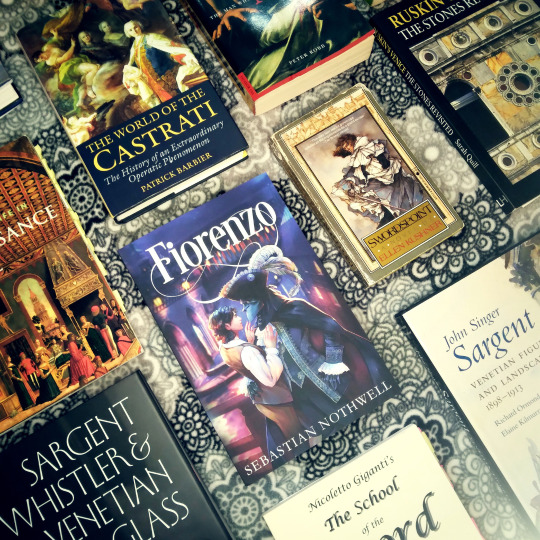
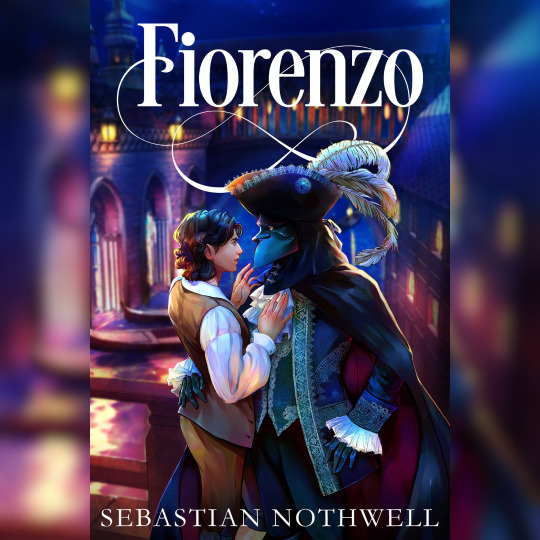
FIORENZO is a queer fantasy-of-manners romance featuring hurt/comfort, swordplay, and a happily-ever-after. And it’s finally out in paperback! Shown here with some of the books that inspired it.
The World of the Castrati by Patrick Barbier Not just a thorough examination of individual castrati lives but also the operatic world that created them. Highly recommended, even (or especially) if you know nothing of opera.
Nicoletto Giganti’s The School of the Sword A swordfighting guide by a fencing master of Renaissance Venice. This book, combined with As You Wish (see below) and Vico Ortiz’s Fencing 101 class proved absolutely essential to making the fight scenes in Fiorenzo possible.
M: The Man Who Became Caravaggio by Peter Robb Come for the art history lesson about a queer Renaissance painter, stay for the tennis court castration duel.
Art and Life in Renaissance Venice and Private Lives in Renaissance Venice by Patricia Fortini Brown While the general history of Venice was necessary (see below), the more specific focus of Brown’s books provided absolutely invaluable insight into the the day-to-day habits of Venice’s historical citizens.
John Singer Sargent: Venetian Figures and Landscapes, 1898-1913 Sargent’s mind-blowing skill with oil portraits is well known, but his watercolour sketches of cityscapes and Venice architecture are truly astounding in their mastery of light and form. Seeing the city through his eyes over a hundred years ago was wildly inspiring.
Sargent, Whistler & Venetian Glass This was an incredible traveling exhibit of Venetian glassware, lace, and other amazing examples of skilled craft alongside paintings by American artists who drew inspiration from Venice in the late 19th and early 20th centuries. I had the good fortune to catch it as it came through Mystic Seaport in Connecticut. It also included an actual Venetian gondola (dry-docked, no felze) which gave me an invaluable sense of just how absolutely huge those things are.
As You Wish: Inconceivable Tales from the Making of The Princess Bride by Cary Elwes and Joe Layden Invaluable insight into the training, choreography, and filming process for one of the greatest swordfighting scenes in cinematic history.
The Princess Bride by William Goldman It’s a swordfighting romance. Enough said.
Swordspoint by Ellen Kushner It’s a queer swordfighting romance. Enough said. (Although I have said far more.)
Ruskin’s Venice: The Stones Revisited by Sarah Quill Venice through the eyes of a Victorian.
Venice: A New History by Thomas F. Madden A general history of Venice was essential in creating Halcyon.
~
FIORENZO is a queer fantasy-of-manners romance featuring hurt/comfort, swordplay, and a happily-ever-after. Available now wherever fine books are found!
Amazon • Apple Books • Barnes & Noble • Bookshop.org • Kobo • Smashwords
#fantasy of manners#john singer sargent#caravaggio#venice#fiorenzo#mannerpunk#swordspoint#the princess bride#queer romance#mm romance#gay romance#historical romance#historical fantasy#romantasy#sebastian nothwell
41 notes
·
View notes
Text
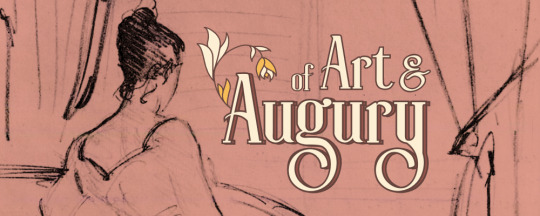
Of Art & Augury: An Interactive Fiction WIP
Genre: Historical Fantasy Format: Text-based interactive fiction Tags: Text-based, historical fiction, romance, fantasy/magic, art and artists, late 19th century Paris Current Status: Drafting (NaNoWriMo 2023 Project)
Synopsis
As a writer for one of the top Parisian society gazettes, you've advised many readers about the up-and-coming artists of the Paris Salon. The best painters there know how to weave subtle enchantments into the likeness of their subject to make the image come to life but, recently, something had been going wrong with the magic. It's up to you to head to the academy and figure out to truth for yourself.
Setting
Set in Paris at the end of the 19th century, you will explore the city and the art exhibitions of the academy. This version of Paris has an undercurrent of magical power which artists use to create enchanted artwork for society.
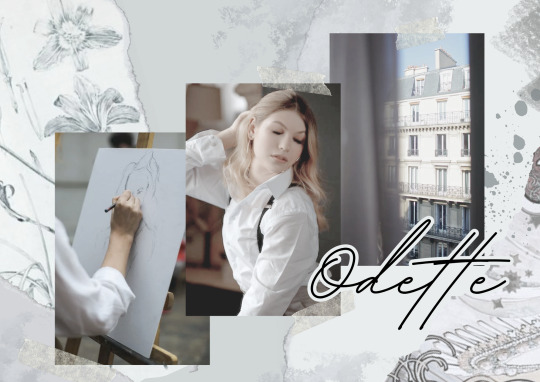


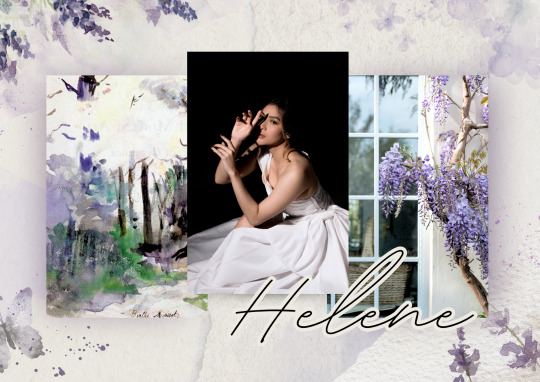
ROs
Odette [F]
Occupation: Commercial Lithographer Artistic Inspiration: Alphonse Mucha Odette is an Austrian artist who moved to Paris to start her career as an artist. She has little formal training and started her career by taking any artistic work she could get her hands on. Now she does mostly lithography for product advertisements and theater posters.
Sainte [M]
Occupation: Journalist Artistic Inspiration: Édouard Manet Sainte was born in Paris and studied under a successful portrait artist from a young age, but left his studies to pursue journalism for reasons he doesn't like to talk about. Now, he works as an art critic for a Parisian newspaper, covering the Salon and other exhibitions.
Armand [M]
Occupation: Portrait Artist Artistic Inspiration: John Singer Sargent Armand has been passionate about art for most of his life and moved to Paris from New Orleans to start his studies when he was still young. He has been studying portraiture ever since and has already painted portraits for some very influential young socialites.
Helene [F]
Occupation: Socialite Artistic Inspiration: Berthe Morisot Helene is a Parisian socialite who fell in love with painting during her private art education growing up. Although her family encouraged her to keep painting, they refused to let her receive any education in enchantment, a requirement for being taken seriously in artistic society. Ever since, she has been trying to teach herself magic in secret.
#writeblr#nanowrimo#nanowrimo wip#if wip#choicescript#choicescript wip#interactive fiction wip#nanowriting#if wip intro#wip intro#wip introduction#original wip#my writing#my wip#if game#interactive fiction
44 notes
·
View notes
Text

Just a fanart of Skye Riley from Smile 2. Inspiration comes from "Portrait of Madame X" by John Singer Sargent.
5 notes
·
View notes
Text
Liam being bi again, let's not ignore it
On his IG live on 7.8.23, Liam said John Singer Sargent is his favorite artist. Sargent's sexuality is heavily debated; modern interpretations are that he was likely gay - at minimum, much more an admirer of the male figure than the female.
Sargent never married, was intensely private about his personal life. X He was a neighbor to Oscar Wilde and would have been very aware of his trial.
Sargent's paintings are often considered homoerotic or "remarking on the fluidity of human sexuality."
Many of his works are sensual portraits of well-built men in generally feminine poses - arched backs, heads thrown back in passion, etc.
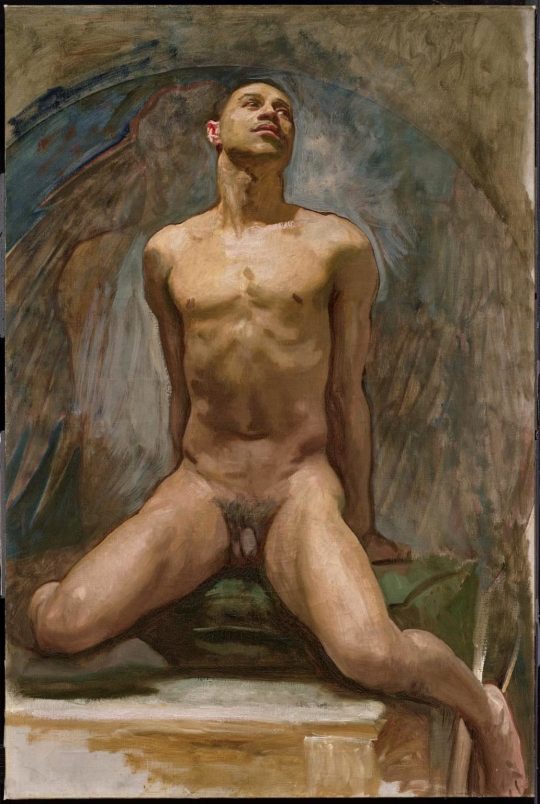
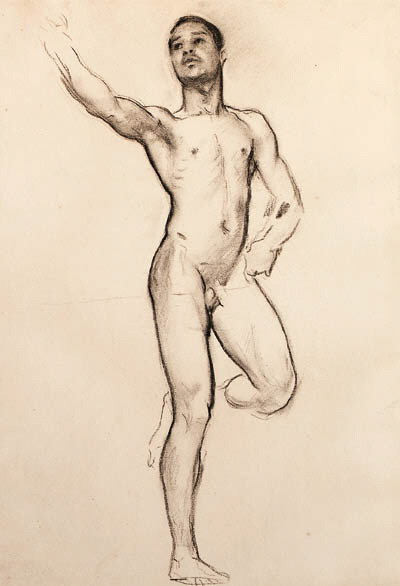
His muse was Thomas Eugene McKellar, a Black bellhop at a posh Boston hotel. Every figure - both women and men - in Sargent's mural at the Boston Museum of Fine Art's rotunda - is McKellar's face - though with his race obscured, and who was paid only a small amount.
He also created many other images of McKellar, one of which he exhibited in his studio his entire life but never showed in an exhibit.
McKellar's family have said they suspected he was gay, and that's why he moved away to Boston.
Some of Sargent's contemporaries remarked about him having many trysts with men when he traveled to Venice and Paris, with a preference for men with darker hair and skin.
Andy Warhol named Sargent as one of his inspirations. Sargent's mural of Hell for the Boston Public Library is thought of as some of his least sensual work - yet when Warhol first saw it, he referred to it as a "gang bang."
On his IG live Liam also read a username that referred to Timothee Chalamet, and before answering the question, he remarked on his attractiveness, twice.
A few days earlier, Liam posted two photos on Instagram of him meeting British artist David Hockney who he called his "inspiration and idol." Hockney is LGBTQ and is known for his intimate portraits of gay domesticity:

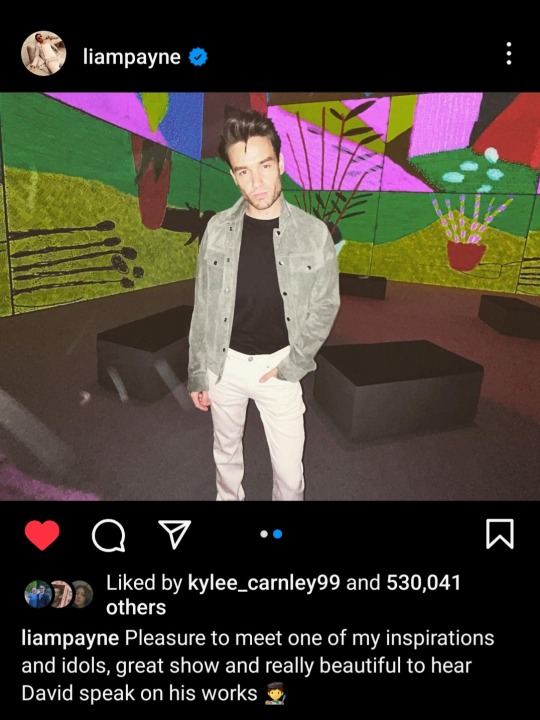
Here is a video of Hockney talking about Harry asking to be painted by him and someone please link the masterpost about Harry queer coding through talking about Hockney.
I'd say Lima mildly flirted with Mark Wahlberg in his thirst trap IG photo comments also x
Besides Ziam, my favorite bi liam content here x
#bi bi bi#bi liam payne#liam payne#queer coding#Liam's sexuality#not even gonna mention ziam in the post#john singer sargent#andy warhol#david hockney#Thomas Eugene McKellar#lgbtq artist#lgbtq artwork#7.8.23
60 notes
·
View notes
Note
hello, your art is absolutely stunning - i can never get over how your character portraits (both the line art and the painting styles) are always so expressive and brimming with personality! i was wondering, if it’s not too personal, if you have any artists or styles that have significantly influenced the development of your own personal style? thank you and have a lovely day!
BJUDHPOHDI ODSi sd THANK YOU SO MUCH !!! You are far too kind and hello !! 🥺
That is not too personal at all— I am actually happy to answer.
I come from an old family of artists and painters and I’ve always adored history and art history ! So my main source is from good old oil paintings and drawings from the old masters.
My most favourite trio, which are artistically my biggest influence are Charles Joseph Frédéric Soulacroix, John Singer Sargent, and Anthony van Dyck.



When I was younger, I've also taken a lot of inspiration from the games Dragon's Crown and Dragon's Dogma. I even tried to draw and paint like these !


For the line art, I don't really know. I haven't really taken inspiration from anyone. It just got more realistic overtime ! I've also started drawing seriously when I was in primary school.
But I can show some old drawings so you can see how I developed :)



I hope you got the answer you hoped for ! I added some more insight into the image descriptions, too. I hope it works.
38 notes
·
View notes
Text

The historiography of Douglas Haig and his role in the waging and eventual winning of the First World War is voluminous and contested. Rightly or wrongly, my own perceptions have been coloured since childhood by Richard Attenborough’s flawed masterpiece, Oh! What a Lovely War (1969), which was released at a moment when the ‘lions led by donkeys’ interpretation of events was at its height (unsurprisingly, given the wave of iconoclasm sweeping the West, as well as widespread opposition to the American involvement in Vietnam). Curiously, the film, in which Haig is played by John Mills, contains a throwaway reference to Lady Haig’s connection with the Royal Family (see previous post). Around the time he was raised to the peerage in 1919, Haig sat to John Singer Sargent, who, somewhat against his will, had been persuaded to embark upon a vast canvas portraying the leading officers of the recently concluded conflict. The finished work, which is now on display in the National Portrait Gallery in London, is not one of his most inspired. Embarrassed though I am to admit it, my chief recollection is of the magnificence of the burnished boots and spurs. Exercised as he was by the obligation to bring together twenty-two uniformed men in one composition, Sargent apparently enjoyed painting studies of the individual sitters. That of Haig hangs in the Scottish National Portrait Gallery in Edinburgh, where I photographed it during my last visit. Brisk though it is, and executed in the final years before the artist’s death, it’s nevertheless an intensely immediate and human thing. This is less ‘The Butcher of the Somme’ - the savage epithet addressed on the placard - and more an image of a direct, self-possessed and fundamentally benign headmaster.
9 notes
·
View notes
Text












Anders Zorn
Anders Zorn (1860–1920) was a renowned Swedish painter, sculptor, and printmaker, celebrated for his exceptional skill in portraiture, nudes, and genre scenes. Born in Mora, Sweden, Zorn rose from humble beginnings to become one of the most prominent artists of his time, achieving international fame and recognition.
Early Life and Education
Zorn was born out of wedlock to Grudd Anna Andersdotter, and his biological father, Leonard Zorn, a German brewer who never married his mother. Raised by his mother and grandparents in a small rural community, young Zorn demonstrated a remarkable talent for drawing and carving from an early age. His prodigious abilities earned him a place at the Royal Swedish Academy of Arts in Stockholm, where he studied from 1875 to 1880.
Artistic Style and Influences
Zorn's work is characterized by his masterful use of light and his innovative brushwork. His paintings often depict scenes of rural Swedish life, portraiture, and the female nude. Zorn developed a distinctive technique that emphasized loose, expressive brushstrokes, capturing the essence of his subjects with remarkable vitality and immediacy. He was particularly adept at rendering the effects of water and light, which became a hallmark of his work.
Zorn was influenced by a variety of artistic traditions and movements. His travels throughout Europe exposed him to the works of the Old Masters, as well as contemporaries like John Singer Sargent and Joaquín Sorolla, with whom he shared a mutual admiration. Despite these influences, Zorn’s style remained uniquely his own, merging elements of Impressionism with his deep-rooted connection to Swedish culture and landscape.
Major Works and Achievements
Some of Zorn's most famous works include his portraits of prominent figures, such as King Oscar II of Sweden, US Presidents Grover Cleveland and William Taft, and industrialist Andrew Carnegie. His portraits are renowned for their psychological depth and lifelike quality.
His genre scenes and nudes are equally celebrated. Paintings like "Midsummer Dance" (1897) and "Emma Zorn" (1894) showcase his ability to depict movement and light with extraordinary skill. Zorn's nudes, such as "Omnibus" (1892), reveal his talent for capturing the human form in naturalistic settings, often emphasizing the interplay between flesh and the surrounding environment.
Printmaking and Sculpture
In addition to his paintings, Zorn was a prolific printmaker, producing over 300 etchings during his career. His prints often featured similar themes to his paintings, including portraits, nudes, and genre scenes. His etching technique was highly regarded for its precision and delicacy.
Zorn also ventured into sculpture, creating several notable works that further demonstrated his versatility as an artist. His sculptural works, though fewer in number, were marked by the same attention to detail and dynamic composition found in his paintings and prints.
Legacy and Influence
Anders Zorn’s impact on the art world extends beyond his lifetime. His works are held in major museums and collections worldwide, including the Nationalmuseum in Stockholm, the Musée d'Orsay in Paris, and the Metropolitan Museum of Art in New York. Zorn’s home and studio in Mora, Sweden, now the Zorn Museum, houses a significant collection of his works and offers insight into his life and artistic process.
Zorn's legacy is also evident in the way he bridged the gap between traditional and modern art. His ability to capture the spirit of his subjects with such vibrant realism continues to inspire artists today. Zorn remains a celebrated figure in the history of art, remembered not only for his technical prowess but also for his profound ability to evoke the beauty and complexity of the human experience.
8 notes
·
View notes
Text
(Companion piece to the fic chapter I just published)
So I mentioned before that for the dresses in Serves You Right and Served Me Well, I tend to take inspiration from art and historical costumes of the 1880s, by which I mean that I swipe stuff and add details I think are fun. I totally stole Inej's black opera-going dress from Madame X, as noted.

Madame X (Madame Pierre Gautreau), John Singer Sargent, 1883-4. (Gown from Maison Félix).
I changed the shoulder straps a little and added some blood-spatter beading, but basically, yeah, that's the dress.
(The main thing I change, in all these dresses, is that most fancy dresses from this period (a) required a bustle, and (b) had trains. I don't know that the management of either would be intuitive to Inej, so I just sort of... erase them.)
Another straight theft: the blue dress of Marya's Kaz has altered for Inej to wear on the first visit to court. You may note (though it's a little hard to tell in digital copy especially) that the woman in the portrait has red hair.

Portrait of Madame Paul Escudier (Louise Lefevre), John Singer Sargent, 1882.
As for what Marya actually wears herself, I imagine most days it's something like this:

Portrait of Mrs. Eleanor Chapman, John Singer Sargent, 1881.
Like you can see a visual kinship to the big lace collars you get in Dutch Masters' paintings, but it's more 19th Century.
The Grand Duchess Durnova's purple dress is sort of a mash-up, as most of the other dresses are:


Coronation Portrait of Tzarina Maria Feodorovna, Vladimir Makovsky, 1885.
Maria Grigorievna Rayevskaya, artist and date unknown.
Inej's blood-orange velvet dress from Serves You Right has a lot of invented details, but the basic shape comes from another dress in a Sargent portrait:


Portrait of Mrs. Charles E. Inches (Louise Pomeroy), John Singer Sargent, 1887
The dress itself, which was altered for a second wearer.
Obviously, I snipped off the arm ribbons and moved them to the gold dress, which is largely inspired by this bodice, designed by famous French design establishment, Maison Worth/House of Worth:

House of Worth, 1890s, seen on the Fripperies and Fobs blog
I love the split bodice, which has various suggestive readings (which, trust me, I will get to). I admit I don't really love the sleeves, though (they loved a goofy sleeve in the 1890s), and the color seemed a little lackluster. Hence: gold watered silk, aka moiré. Moiré is notoriously hard to photograph, since it shifts with the light. But this is a contemporary garment (from Saudi boutique Aetelier Heyakat) which shows off the effect pretty well by having long, uninterrupted lines.

For the Grand Duchess's gold dress, I was thinking more of something yellower, like this:

Attributed to Liberty & Co. of London, 1880s.
Anyway, there will probably be more dresses so I will try to make another post if there's anything cool to show.
37 notes
·
View notes
Note
hiiii courtney, who is an artist you can't live without?
hiii ish!! oh my goodness, there's so many 😭😭 but i'll give you three that i'm really feeling inspired by right now: keita takahashi (designer for katamari damacy), sam raimi (for specifically evil dead reasons), andddd i'm gonna say john singer sargent (his portrait work has been such a huge inspiration for me since high school)
#asks#but genuinely theres like hundreds if not thousands i could list!#its so hard to pick just a few--i love it all
24 notes
·
View notes